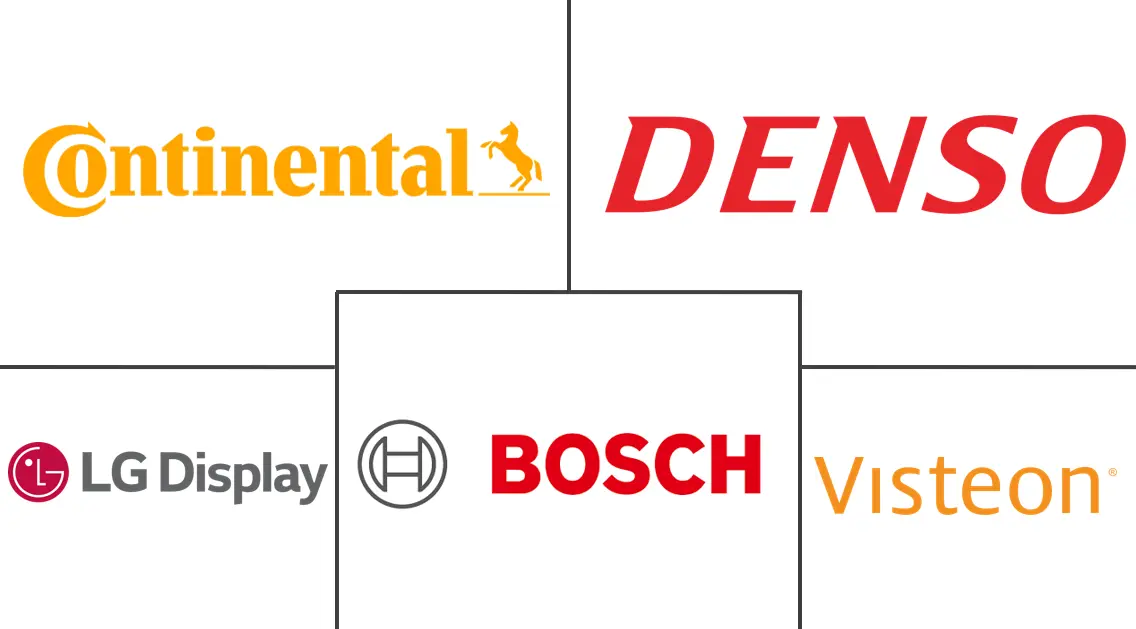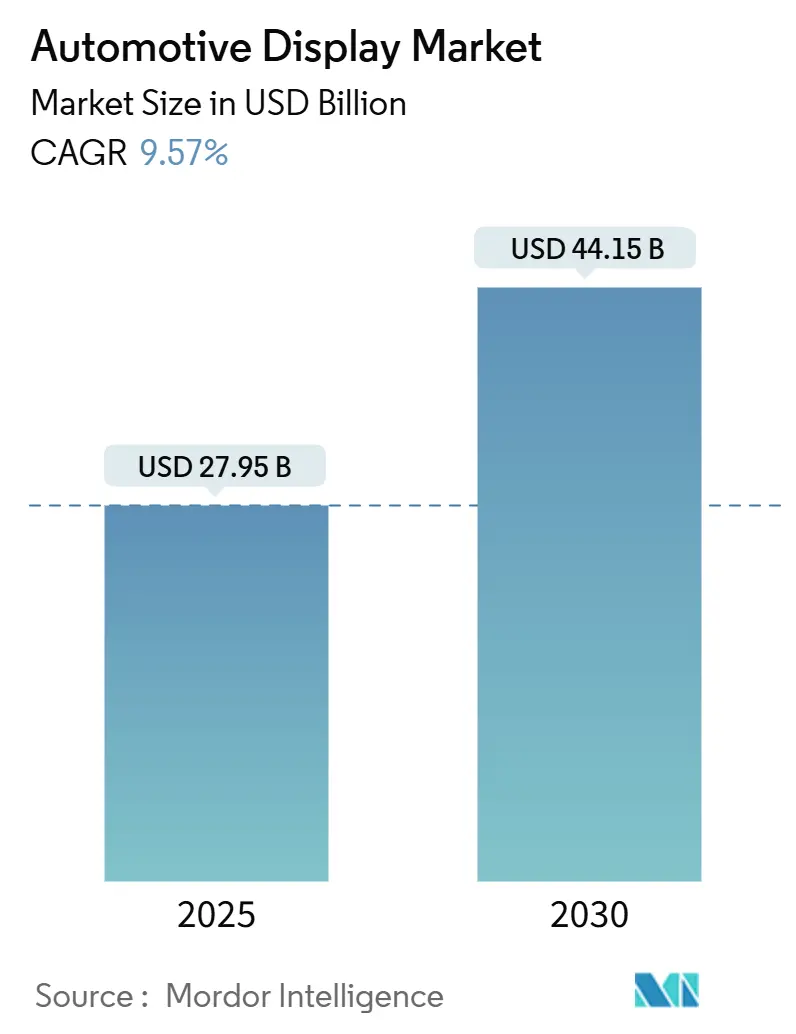
Automotive Display Market Analysis by Mordor Intelligence
The automotive display market size is valued at USD 27.95 billion in 2025 and is forecast to reach USD 44.15 billion in 2030, advancing at a 9.57% CAGR during the period. Expanding software-defined vehicle architectures, stronger demand for immersive infotainment, and rising levels of driving automation push displays from simple information read-outs to core human-machine-interface (HMI) assets. Automakers are integrating more screen real estate to support over-the-air (OTA) feature rollouts, remote diagnostics, and subscription-based content. High-brightness liquid-crystal-display (LCD) modules continue to dominate volume production thanks to mature supply chains, while organic-light-emitting-diode (OLED) and Mini LED alternatives concentrate on premium trims to justify higher unit pricing.
Key Report Takeaways
- By product type, center stack displays led with a 39.61% revenue share in 2024, while HUDs recorded the fastest projected CAGR at 10.14% through 2030.
- By display technology, LCD modules retained 64.05% of sales in 2024; OLED is expected to expand at a 10.42% CAGR to 2030.
- By vehicle type, passenger cars captured 75.31% of demand in 2024, whereas commercial vehicles are forecast to post an 11.08% CAGR across the outlook period.
- By display size, the 6–10 inch class accounted for 54.11% of shipments in 2024; ≥10 inch panels are anticipated to grow at a 10.81% CAGR to 2030.
- By geography, Asia-Pacific dominated with a 45.85% revenue share in 2024 and is slated to post the highest regional CAGR of 11.77% through 2030.
Global Automotive Display Market Trends and Insights
Drivers Impact Analysis
| Driver | (~) % Impact on CAGR Forecast | Geographic Relevance | Impact Timeline |
|---|---|---|---|
| Connected- & Electric-Vehicle HMI Needs | +2.3% | Global, led by China & EU | Long term (≥ 4 years) |
| Integrated Digital Cockpits | +2.1% | Global (strongest in Asia-Pacific) | Medium term (2-4 years) |
| OTA User-Experience Refresh Cycles | +1.9% | Global, premium marques first | Long term (≥ 4 years) |
| High-brightness LCD Cost Reduction | +1.8% | Global, price-sensitive regions | Short term (≤ 2 years) |
| Pillar-to-Pillar Screen Adoption | +1.5% | North America & Europe premium models | Medium term (2-4 years) |
| NCAP Distraction-Score HUD Push | +1.2% | Europe & North America | Short term (≤ 2 years) |
| Source: Mordor Intelligence | |||
Rise of connected & electric vehicles needing richer HMI
EV powertrain complexity and cloud-linked vehicle-road-infrastructure connectivity demand graphical interfaces that surface battery health, route-based range estimates, and V2G (vehicle-to-grid) transactions. Hyundai reports strong buyer interest in charge-planning tools embedded within its central display, highlighting the link between intuitive graphics and reduced range anxiety.
Soaring demand for integrated digital cockpits
Unified cockpit platforms consolidate instrument clusters, infotainment, and climate controls onto shared operating systems. HARMAN’s Linux- and Android-based cockpit suite streams content across domains, lowering electronics complexity and creating room for AI-driven personalization [1]“Intelligent Cockpit Platform Overview,” HARMAN International, harman.com. Suppliers apply digital-twin modelling to cut physical prototyping time; Faurecia’s model-based design shrinks development cycles, aligning with automakers’ software time-to-market targets. OTA support within the cockpit enables post-sale feature unlocks, cementing recurring-revenue models.
Software-defined vehicle OTA UX refresh cycles
Continuous integration pipelines allow automakers to refine in-vehicle UIs even after delivery. Marelli’s software-defined vehicle (SDV) stack virtualizes cockpit domains in the cloud, enabling feature testing ahead of deployment. LG Electronics’ AlphaWare environment lets OEMs tailor graphics quickly, pushing displays toward service-oriented architectures that support subscription bundles.
NCAP distraction-score rules accelerating HUD fitment
Euro NCAP’s assessment protocol awards vehicles that minimize visual time away from the roadway; OEMs answer with AR-enabled HUDs overlaying speed, navigation, and ADAS cues directly in the driver’s line of sight [2]“Assessment Protocol—Safe Driving,” Euro NCAP, euroncap.com. Hyundai Mobis and Zeiss are co-developing holographic optics to improve brightness under sunlight and maintain visibility through polarized sunglasses.
Restraints Impact Analysis
| Restraint | (~) % Impact on CAGR Forecast | Geographic Relevance | Impact Timeline |
|---|---|---|---|
| Glass and Semiconductor Supply Volatility | -1.8% | Global, high Asia-Pacific exposure | Short term (≤ 2 years) |
| Premium Pricing of Automotive-Grade OLEDs | -1.4% | Global, value segments most affected | Medium term (2-4 years) |
| Rising Cybersecurity Compliance Costs | -1.1% | EU & North America | Long term (≥ 4 years) |
| Reliability Issues in Large Flexible Panels | -0.9% | Global premium segments | Medium term (2-4 years) |
| Source: Mordor Intelligence | |||
Glass & semiconductor supply volatility
High-purity quartz and legacy-node semiconductors experienced intermittent shortages in 2024–2025, exposing the fragility of concentrated sourcing. Hurricane damage to key quartz facilities constrained glass substrate output, while geopolitical tensions around gallium and germanium sharpened risk profiles for display driver integrated circuits. Tier-1s now dual-source and regionalize inventory buffers to harden supply resilience.
Premium pricing of automotive-grade OLEDs
Tight qualification standards around temperature cycling and lifespan inflate automotive OLED costs. Replacement of a damaged central OLED can exceed USD 15,000, confining adoption mainly to luxury badges [3]“Cost Analysis of Automotive-Grade OLED Replacement,” Interelectronix, interelectronix.com. Tandem-stack designs improve luminance but add layer count, raising materials outlay and keeping price gaps versus high-end LCDs intact.
Segment Analysis
By Product Type: Center-stack prevalence with HUDs surging
Center-stack consoles held 39.61% of revenue in 2024, underlining their role as the vehicle’s command center. The segment benefits from scalable screen sizes, touch-first interaction, and app-store compatibility that align with the automotive display market’s shift to software monetization. HUD fitment is rising fastest at a 10.14% CAGR, buoyed by safety legislation and consumer demand for glance-free navigation cues. Combined, both product lines exemplify how the automotive display market supports tiered UX strategies—comprehensive control panels for deep interaction, and windshield projections for critical driver alerts.
Increasing domain-controller adoption allows content rebalancing between clusters, HUDs, and passenger screens. Visteon secured USD 2.6 billion in cockpit contracts during 2024, many bundling multiple display types into one hardware-software stack that simplifies validation and shortens launch timelines.
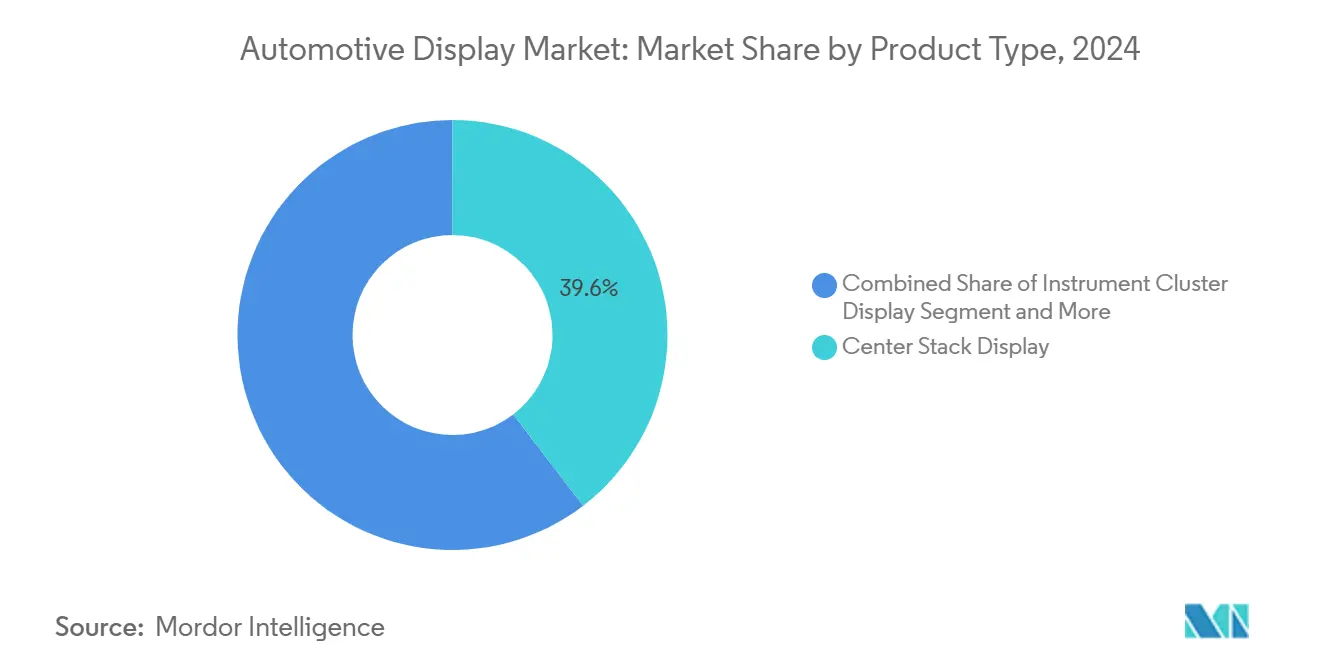
Note: Segment shares of all individual segments available upon report purchase
By Display Technology: Cost-mature LCD volume, OLED leads premium growth
LCD modules captured 64.05% of shipments in 2024 thanks to long-established fabs, falling driver-IC pricing, and a growing slate of Mini LED enhancements that elevate contrast without premium pricing. Mass-market dashboards, digital clusters, and fleet displays continue to rely on LCD’s predictable cost roadmap, ensuring the technology remains the backbone of automotive HMI for the forecast window.
OLED is the fastest-growing technology, projected to advance at a 10.42% CAGR by focusing on high-contrast curved clusters, flexible center stacks, and pillar-to-pillar treatments that command premium trim pricing. Samsung Display’s Dolby Vision-certified panels now reach peaks above 1,500 nits, narrowing daytime-visibility gaps versus LCD and justifying OEM upgrades. MicroLED prototypes are also emerging, yet their commercial timeline extends past 2030, leaving LCD and OLED to define mainstream technology choice in the interim.
By Vehicle Type: Passenger-car strength balanced by commercial-vehicle upswing
Passenger cars generated 75.31% of automotive display revenue in 2024, a lead secured by high consumer appetite for connected infotainment, dual-screen layouts, and augmented-reality head-up displays. Automakers install larger and brighter center stacks as differentiators, while subscription-based software services keep post-sale revenue flowing and strengthen the business case for ever-richer graphics.
Commercial vehicles, though smaller in absolute volume, are on track for an 11.08% CAGR to 2030 as fleets electrify and adopt cloud-driven route optimization dashboards. Electric trucks need battery-state visualization, regenerative-brake feedback, and compliance reporting that analogue clusters cannot deliver. Growing emphasis on driver monitoring and safety analytics further enlarges display real estate inside cabs, turning truck cockpits into data hubs that mirror cloud fleet portals.
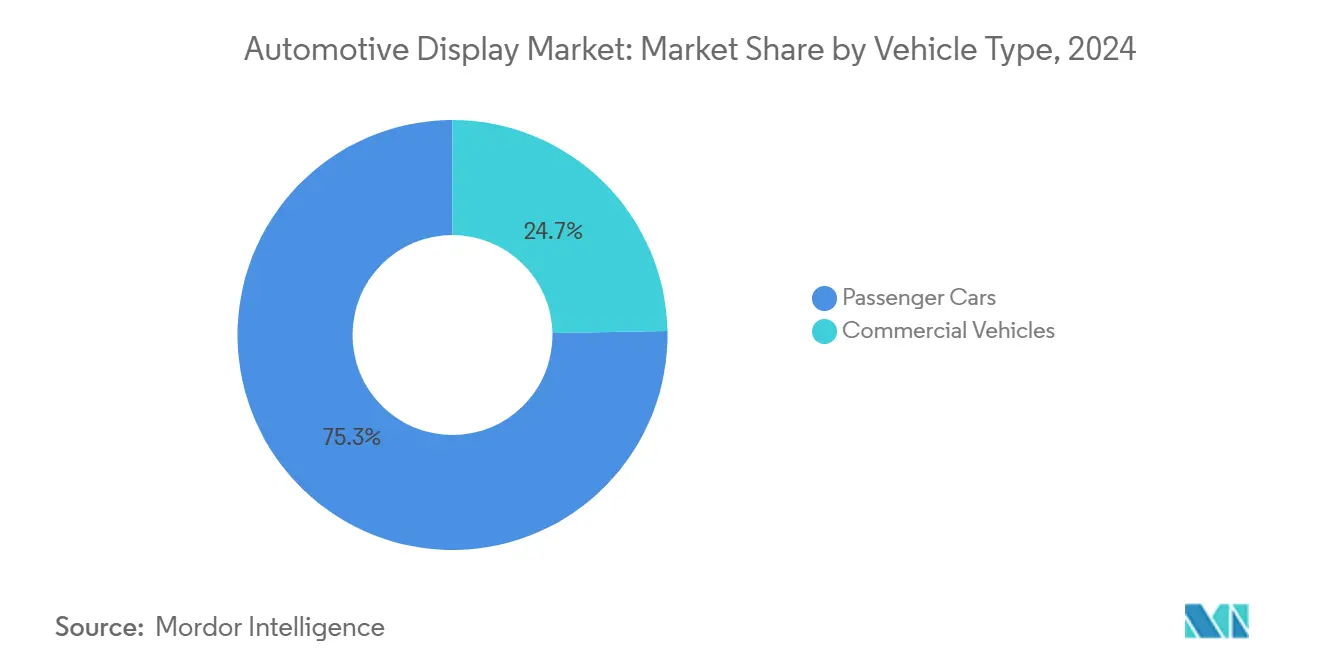
By Display Size: Mid-size panels anchor volumes while large formats surge
Panels between 6 in and 10 in held 54.11% of unit shipments in 2024, striking the optimal balance among cost, ergonomics, and regulatory distraction limits. Mid-size screens satisfy mainstream models where infotainment, navigation, and HVAC controls converge into a single touch interface that OEMs can easily brand-tune.
Displays larger than 10 in will grow at a 10.81% CAGR through 2030, boosted by premium EVs and SUVs that convert the dashboard into a panoramic digital canvas. Pillar-to-pillar layouts showcase multi-zone video, passenger gaming, and split-screen navigation, all while privacy filters and zoned dimming mitigate distraction. As manufacturing yields improve and Mini LED backlights lower material costs, large-format adoption will expand beyond the luxury tier.
Geography Analysis
Asia-Pacific remained the largest automotive display market, accounting for 45.85% of 2024 revenue and projected to grow at an 11.77% CAGR through 2030. China anchors the region’s dominance; domestic brands install 12-inch or larger center screens as standard and benefit from integrated semiconductor, panel, and vehicle-assembly ecosystems that compress development cycles and lower cost. Local governments invest in vehicle-road-cloud infrastructure, enabling data-intensive cockpit functions without latency penalties.
North America follows as a technology-rich arena where high content per vehicle drives sizable revenue despite smaller unit totals. U.S. light-vehicle production reached 16.46 million units in 2024, and HUD penetration rose alongside Level-2+ driver-assistance packages. Silicon Valley software hubs shorten OTA update cycles and reinforce consumer expectations for mobile-app-like cockpit experiences.
Europe completes the top three with a regulatory push that prioritizes safety and sustainability. Euro NCAP’s forthcoming distraction metrics and Euro 7 emissions limits accelerate electric-vehicle adoption and, by extension, demand for advanced displays that visualize energy usage and driver-monitor data. German premium marques lead in curved OLED clusters and dashboard-wide glass laminates, giving the region an outsized influence on next-generation cockpit styling.
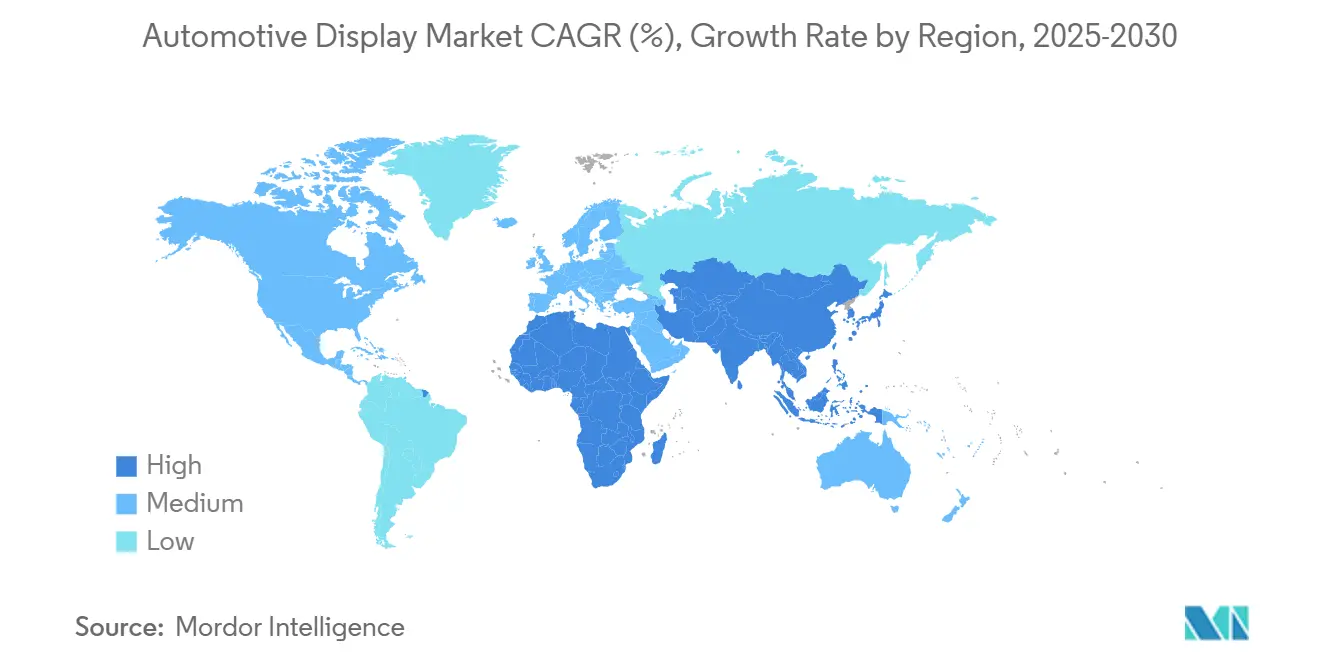
Competitive Landscape
Competition straddles three clusters, Tier-1 automotive electronics groups (Continental, Bosch, Denso), display-panel giants (LG Display, Samsung Display, BOE), and software-centric cockpit specialists (ECARX, HARMAN). As cockpit value migrates toward code, hardware-agnostic operating systems become decisive. Continental’s domain-controller roadmap integrates real-time Linux kernels and cyber-resilience layers, positioning the firm for ISO/SAE 21434 compliance while preserving system modularity.
Panel houses deploy vertical integration to secure long-term capacity agreements. BOE ramps Gen-10.5 fabs, aiming to displace Korean incumbents in large automotive LCD, compressing average selling prices and forcing rivals to speed premium-tech transitions. Software-defined-vehicle (SDV) newcomers such as ECARX reported USD 761.9 million 2024 revenue as Android-based cockpit solutions entered Volkswagen Group models, signalling OEM appetite for agile code pipelines over bespoke hardware.
Patent filings intensify around high-dynamic-range (HDR) algorithms, eye-tracking middleware, and low-reflection cover-glass coatings. Litigation risk rises, nudging players toward cross-licensing frameworks; Panasonic and Magna recently exchanged ADAS-related patents to reduce blockage scenarios and co-develop integrated cockpit-ADAS stacks.
Automotive Display Industry Leaders
-
Denso Corporation
-
Robert Bosch GmbH
-
Visteon Corporation
-
Continental AG
-
LG Display Co., Ltd.
- *Disclaimer: Major Players sorted in no particular order
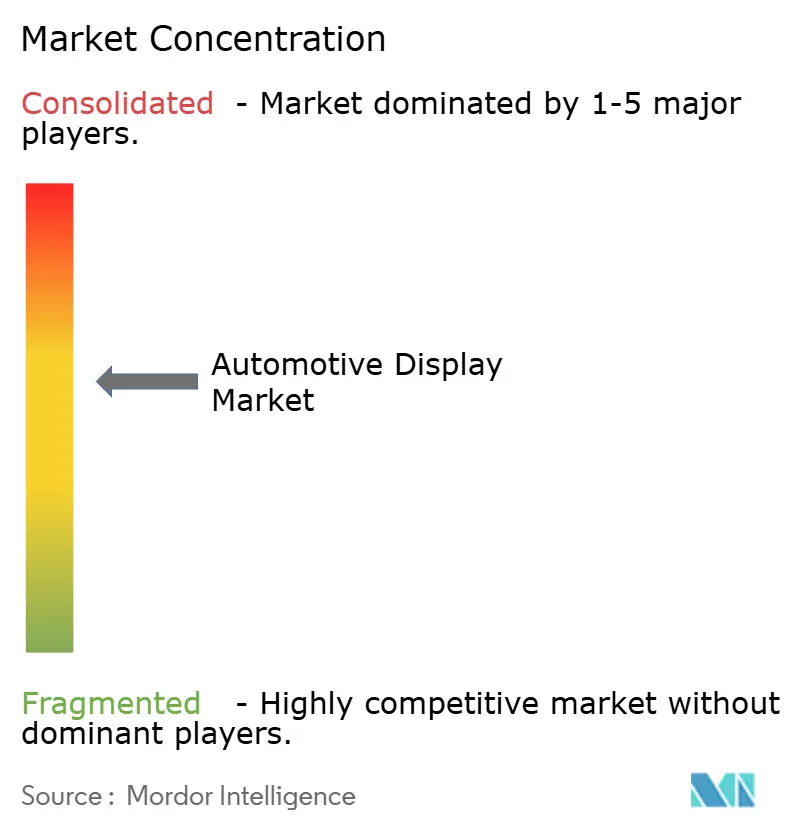
Recent Industry Developments
- February 2025: LG Display began mass production of a 40-inch pillar-to-pillar panel with switchable privacy mode for Sony Honda Mobility’s Afeela sedan.
- December 2024: Samsung Display partnered with Dolby Laboratories to pre-tune automotive OLEDs for Dolby Vision HDR.
- October 2024: Hyundai Mobis and Zeiss launched a joint project to engineer holographic HUD optics compatible with polarized sunglasses.
- May 2024: LG Display showcased a 20% thinner Advanced Thin OLED stack aimed at curved cockpit surfaces during SID Display Week.
Research Methodology Framework and Report Scope
Market Definitions and Key Coverage
Our study defines the automotive display market as all factory-installed visual interfaces, center stacks, instrument clusters, head-up units, rear-seat screens, and any integrated touch or gesture panels supplied to passenger and light commercial vehicles worldwide.
Scope Exclusion: Retrofit aftermarket kits and detachable consumer tablets are not considered.
Segmentation Overview
- By Product Type
- Center Stack Display
- Instrument Cluster Display
- Head-Up Display
- Rear-Seat Entertainment Display
- By Display Technology
- LCD
- OLED
- MiniLED / MicroLED
- By Vehicle Type
- Passenger Cars
- Commercial Vehicles
- By Display Size
- Less than equal to 5-inch
- 6 to 10 inch
- Above 10 inch
- By Geography
- North America
- United States
- Canada
- Rest of North America
- South America
- Brazil
- Argentina
- Rest of South America
- Europe
- Germany
- United Kingdom
- France
- Rest of Europe
- Asia-Pacific
- China
- Japan
- India
- South Korea
- Rest of Asia-Pacific
- Middle East and Africa
- United Arab Emirates
- Saudi Arabia
- Egypt
- Turkey
- South Africa
- Rest of Middle East and Africa
- North America
Detailed Research Methodology and Data Validation
Primary Research
Discussions with tier-1 cockpit integrators, panel fabs, and procurement managers across Asia, Europe, and North America helped validate attach-rate assumptions, price erosion paths, and likely OLED-to-LCD mix shifts. Consumer-side surveys in China, Germany, and the United States clarified the acceptable premium for larger screens and augmented reality HUDs.
Desk Research
Analysts began with publicly available datasets such as OICA vehicle production tallies, UN Comtrade LCD / OLED panel trade codes, ACEA new-car registrations, and Transportation Research Board safety papers. These were enriched with insight from display-focused bodies such as the Society for Information Display, plus filings and investor decks from leading panel makers that disclose automotive revenue splits. To cross-check cost curves and supplier health, D&B Hoovers and Dow Jones Factiva were queried for multi-year financials. Additional color came from regulatory portals, NHTSA driver-distraction guidelines, and EU General Safety Regulation notes, which signal mandatory fitment timelines. The sources listed are illustrative, and many other repositories informed the evidence base.
Market-Sizing & Forecasting
A top-down build starts with annual vehicle assemblies by segment, which are then multiplied by display attach rates that differ by drivetrain, trim line, and regulation. Results are corroborated through bottom-up checks, sampled supplier shipments, and average selling price snapshots to fine-tune totals. Key variables include: - EV share of production (strongly lifts screen count) - Average diagonal size migration curve - ASP delta between LCD and OLED panels - Regional safety mandates that force rear-view camera displays - GDP-adjusted consumer tech adoption index Multivariate regression projects each driver to 2030; scenario analysis layers in supply chain shocks and policy swings before finalizing the base case.
Data Validation & Update Cycle
Outputs pass a three-tier review: automated outlier scans, peer analyst challenge, and senior sign-off. When quarterly earnings, policy announcements, or recall events shift underlying metrics, an interim refresh is triggered; otherwise, figures are renewed annually, and a last-minute pass ensures clients receive the latest view.
Credibility Anchor: Why Mordor's Automotive Display Baseline Commands Reliability
Published estimates rarely match because firms vary scope, price-decay curves, and refresh cadence. Our disciplined selection of all key vehicle classes, verified attach rates, and dual-path modeling keeps numbers balanced and traceable.
Key gap drivers include rivals focusing only on passenger cars, freezing ASP erosion at a flat percent, or carrying forward pre-pandemic production baselines.
Benchmark comparison
| Market Size | Anonymized source | Primary gap driver |
|---|---|---|
| USD 27.95 B (2025) | Mordor Intelligence | - |
| USD 16.00 B (2024) | Regional Consultancy A | Excludes HUDs and commercial vehicles; relies on unit × single ASP only |
| USD 14.72 B (2023) | Global Consultancy B | Uses conservative build volumes and static panel-price ladder |
In sum, the tighter scope definition, dynamic pricing curves, and yearly validation steps that Mordor analysts employ provide decision-makers with a dependable, mid-ground baseline that can be replicated and audited with publicly obtainable inputs.
Key Questions Answered in the Report
What is the current value of the automotive display market?
It stands at USD 27.95 billion in 2025 and is on track to reach USD 44.15 billion by 2030.
Which display technology leads global automotive adoption?
LCD modules command 64.05% of 2024 shipments because of cost advantages and mature tooling.
Why are head-up displays growing faster than other product types?
Safety regulations in Europe and North America reward reduced driver distraction, driving demand for HUDs through 2030.
How do software-defined vehicles affect display demand?
OTA feature roll-outs and subscription services require larger, adaptable screens that can support frequent UX refreshes.
Page last updated on:
